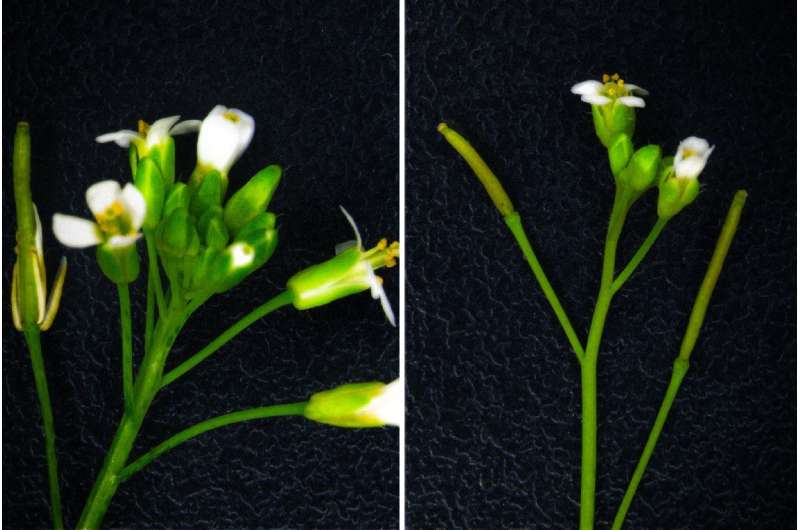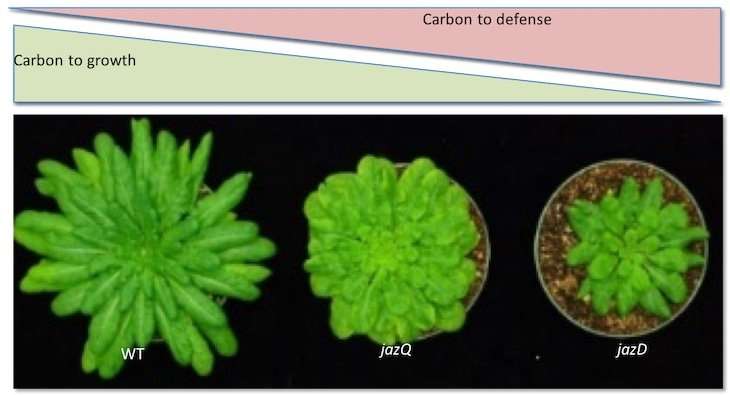Overspending on defense arsenal bankrupts a plant's economy

Defend or grow? Can plants do both at the same time? Michigan State University scientists might be inching closer to answering these questions. The answers matter. They could someday help us understand natural ecosystems or help farmers increase yields, without increasing dependence on chemicals to resist pests.
The lab of Gregg Howe at the MSU-DOE Plant Research Laboratory has genetically tuned a plant to become highly resistant to insect attacks. But becoming such a fortress compromises its growth and procreative capabilities. The research is published in Proceedings of the National Academy of Sciences.
The findings seem to support a long-held paradigm called the growth-defense trade-off. It goes something like this: plants work with a fixed energy budget. So, they prioritize resource usage depending on need. If they spend more energy on growth, their defenses are compromised. On the other hand, having more defense capabilities penalizes growth.
Plants, in nature, seem to follow this general rule. When stressed by drought, disease, or insect pests, plants will mount defensive responses, which typically slows growth to a crawl. But if plants have to grow fast, for example to compete with neighbors for light, their defenses are weakened.
"Our study provides evidence that large investments in defense necessarily reduce the amount of resources that otherwise would be available for growth and reproductive fitness," says Qiang Guo, a graduate student in the Howe lab.
The study focuses on the defense system against herbivores, which depend on plants for shelter and food. If a caterpillar starts munching on a leaf, the system produces toxins that ward it off. But in the absence of danger, the plant shuts down its defense system with a battery of 13 repressor proteins, called JAZ, that put the brakes on defense in order to save energy.
A former post-doc in the Howe lab, Yuki Yoshida, genetically bred a plant missing 10 of these 13 repressor proteins. The result was a plant in continuous, overdrive defense mode.
"It kept producing defense compounds, even in the absence of threats. As expected, it showed high resistance to insects," says Guo. "Unleashing this defense arsenal also provided protection against fungi that target plant tissues."

Plants must balance their budgets too
Alas, there are dire consequences to a strong plant without.... "All that JAZ."
"They have a much slower growth rate compared to their wild type counterparts. We can literally see and measure the deficit in growth rate per day."
The plants also have strongly compromised reproductive success. They produce 1/3rd fewer seeds, and those seeds germinate later than usual. The seeds tend to be smaller and of lower quality, packed with less nutritional fats and with a different lipid make-up.
The team ruled out that photosynthesis—which is how plants obtain energy resources—was compromised. Enter Ian Major, a post-doc in the Howe lab.
"The mutated plant gets the same amount of energy compounds from photosynthesis as its wild, natural counterpart," Major says. "However, it consumes more energy than usual. We think the plant is fueling the massive and constant production of defense compounds, which draws resources away from growth.
Guo adds that the high-energy usage starves the plants of nutrients. "It doesn't have enough energy to perform other functions optimally, like growth" he adds. "To illustrate that point, we fed the plant with sugar, a fuel source, and it partially recovered its growth."
"Our conclusion is that JAZ proteins help plants grow and reproduce by taming their defenses when the threat of attack is low, which conserves energy. Depending on the severity of the threat, the JAZ proteins will dial up the defenses as needed, perhaps like a dimmable light switch, ," Major says.
The research team highlights the importance of Dr. Yoshida's ten-year effort to knock out the JAZ proteins, one by one. "He ignored a lot of us when we told him it was a high-risk, difficult project. But now, we have new ways of thinking about plants and how we can combine plant traits in new and useful ways," Major says.
More information: Qiang Guo el al., "JAZ repressors of metabolic defense promote growth and reproductive fitness in Arabidopsis," PNAS (2018). www.pnas.org/cgi/doi/10.1073/pnas.1811828115
Journal information: Proceedings of the National Academy of Sciences
Provided by US Department of Energy





















